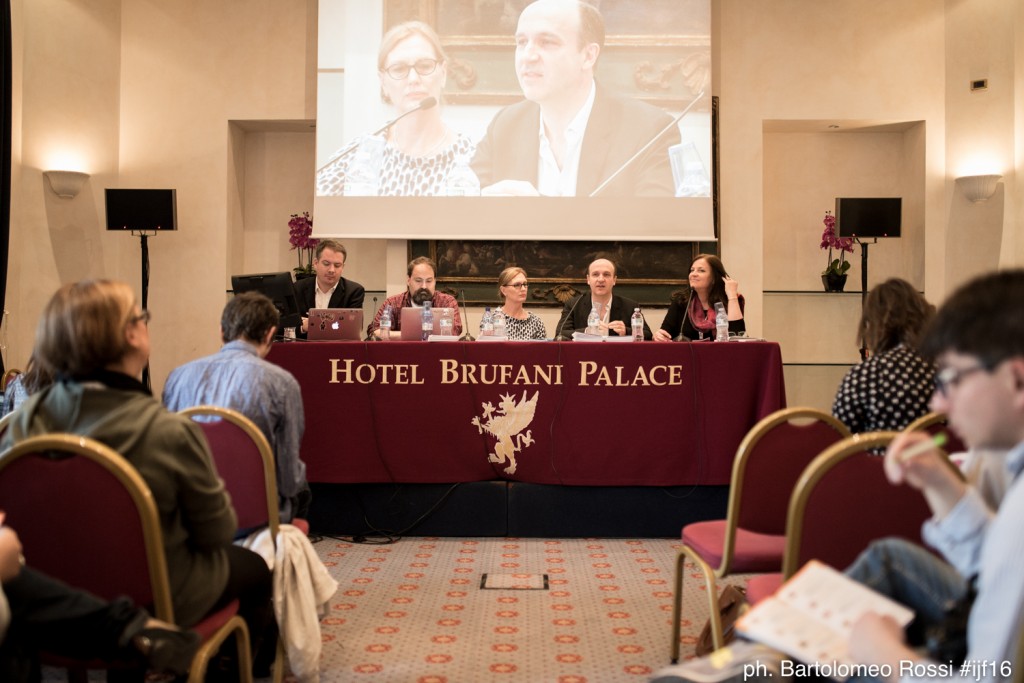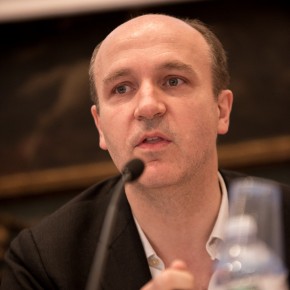
The violent videos from the Arab Spring came in a trickle at first.
Andy Carvin, then social media editor for NPR, treated them solemnly. He turned off music. He asked people around him to stop talking. And he watched quietly – and with focus.
As more and more videos appeared online, Carvin treated them less and less solemnly. He allowed others around him to talk. He continued to listen to music.
“I turned into the proverbial TV detective who would be standing over a dead body and eating a ham sandwich,” he told an audience of several dozen people, during the panel discussion “Making secondary trauma a primary issue” at the International Journalism Festival in Perugia.
“It wasn’t until another six months later that I realised I really had a problem on my hands.”
That problem manifested in food.
Carvin said he started to associate cauliflower and broccoli with body parts. He would see a bowl of cauliflower in a restaurant, panic and leave.
Then it wasn’t just the appearance of the food; it was the smell.
“If I smelled someone cooking broccoli or cauliflower, I would feel my heart rate shooting up,” Carvin said.
Though Carvin had not observed the violence of the Arab Spring firsthand, his body was responding as if he had.
He was suffering from vicarious trauma.
More and more journalists around the world are suffering in a similar – though maybe not as severe – way.
It’s not just foreign correspondents and battle zone reporters. Newsroom managers are seeing symptoms of vicarious trauma or secondary post-traumatic stress among photography editors, social media managers, radio and television call-in handlers and others, said BBC News manager Kate Riley.
Riley said the trauma is especially prevalent among digital teams because they often are composed of younger, less experienced journalists.
Eighty-nine percent of journalists who responded to a 2015 Eyewitness Media Hub survey said they were exposed to distressing photos and videos several times per week as part of their job responsibilities. Fifty-five percent of all respondents said they were exposed to distressing photos and videos daily.
Thirty-seven percent of all respondents said the regular exposure to distressing images had a negative impact on their personal lives.
Carvin, Riley and the other panellists said images of violence are not necessarily more prevalent, but seem that way because of the frequency with which they appear, the places where they appear and the nature of the content.
“There’s the idea of surprise,” said Sam Dubberley, co-founder of Eyewitness Media Hub.
“You’re viewing content you weren’t ready to see.”
That content can appear in an individual’s newsfeed dozens of times due to shares and retweets.
And the individual might not have the choice to see it or not because Facebook, Twitter and other networks now automatically play videos “whether you want to see it or not,” Carvin said.

Gavin Rees, director of Dart Centre Europe, said the content might be made to be emotionally disturbing.
“It’s not just the image; it’s the meaning of the image,” Rees said.
“If ISIS killed people and filmed themselves killing people, they’re propagating the images for propaganda. They want to get in our heads.”
The trauma occurs because our fight-or-flight instinct is thousands of years older than our intellectual understanding of social media.
“One’s body in a newsroom doesn’t necessarily know that scary man holding a knife in Iraq isn’t actually in the room with one,” he said.
Rees said it is important that every journalist understand the risks associated with regularly viewing violent content and develop a plan for dealing with the associated trauma.
Managers need to address the problem in their newsrooms, Dubberley said.
Respondents to the Eyewitness Media Hub survey said the most useful resources for dealing with secondary post-traumatic stress are regular breaks, relevant training, debriefings with managers, and peer support networks. Respondents to the survey also said those were the least available resources.
BBC News has spent years developing a program for dealing with secondary post-traumatic stress, Riley said.
The organisation’s leaders have been making many aspects of its hostile environment training a part of regular training. They also have been talking more about secondary post-traumatic stress and trying to reduce the stigma associated with asking for support.
BBC also covers the cost of some counseling sessions for those who seek support.
Carvin, who now edits Reported.ly, said he has been trying to build the concept of “duty of care” into everything the organisation does.
Each of the Reported.ly staff members works remotely, which can contribute to feelings of isolation when dealing with traumatising imagery, so staff members work in a buddy system with at least two of them online at the same time, Carvin said. That way, each staff member has someone to talk with about whether to share the content or how the content affects them.
They talk on a Slack channel throughout the day.
“We’ve all gotten to recognise when someone is having a bad day,” he said. “We try to do what we can to distract them from it and use back channels to communicate.”
They try to share things to cheer each other up, including a lot of cat videos.
But there have been occasions when something has happened that has been so traumatic that Carvin has shut down operations and given staff a three-day weekend, he said.
Rees said practicing breathing techniques, progressive muscle relaxation or yoga can help. Exercise is good, too, because it uses excess adrenaline, he said.
Rees also recommended developing an appropriate work flow. He advised against looking at violent photos and videos before bed.
“Trauma takes away control,” he said. “Any kind of strategies, anything at all really, that helps us to push back a little and regain control… is really important.”